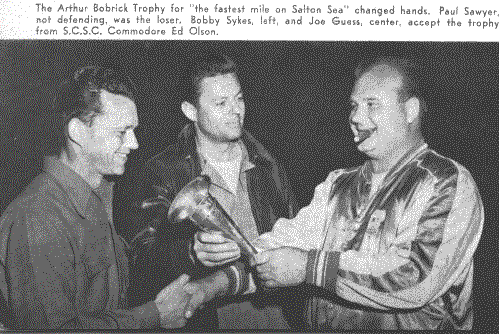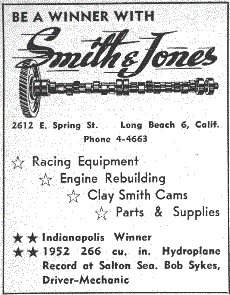
Hydroplane Racing
Early 50's Style
Click Hydro Above For Pictures

There is Nothing More Beautiful in the World of Motor Sports
Than a Hydroplane Dancing on the Water
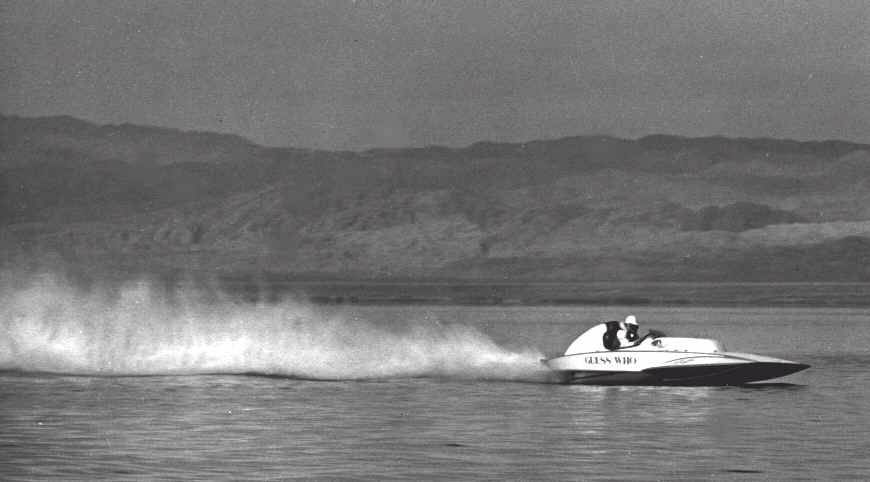
"Dad" Bobby Sykes Sr. "Hanging It Out" Driving "GUESS WHO"
Salton Sea California 1952. 266 Hydro Class
A New FIA World Record of 121. 703 MPH for the Flying Mile.
Engine 258 Cubic Mercury Flathead with Hilborn Fuel Injection & Smith and Jones Cam
A Story from February 1953 "Speed and Spray" Magazine
The
"Guess Who"
Story
By Kenny Harmon
Photos by Kent Hitchcock
Perhaps we should call this article the "Joe Guess" Story. Without Joe there would be no story.
This thing really started during the summer of 1938, down by the railroad tracks. Alongside the tracks was a straight stretch of pavement, with few intersections. This was used as sort of a 'drag' strip by the local gentry. Putting along (flat out) on a four valve Rudge that belonged to a friend of mine, I passed Joe who was tinkering with a midget car. Not the race car variety, but a cute little job that had a bucket seat and an oval gas tank on back. I had never met Joe before but it wasn't long before he was over in my garage to look at my 135 hydro. The next Sunday Joe had his first ride in a fast boat (we thought it was fast), anyhow, that did it. It wasn't long before the midget disappeared and Joe was building a boat. Joe has been building a boat ever since.
To say that Joe builds a boat is to make a great big understatement. These things are projects, very carefully planned. Joe's labor assumes the proportions of a career. Time means nothing. One year, year and a half, two years, no hurry. The result? A masterpiece that equals anything seen at Indianapolis in the way of top quality.
Joe, who calls Rosemead, California home, is a quiet unassuming guy who looks more like a movie actor than a mechanic. Superintendent and part owner of a large fabricating plant, Joe is a whiz when it comes to making anything and I mean anything. You could give him an old rusty file and a broken down cutting torch and he would come up with a Swiss watch if you gave him enough time. Close attention to small details brand Joe as a perfectionist. For example, where possible, all welds are buffed out into smooth fillets. This includes the boat trailer as well. Nothing is left unfinished. Bolts are of exact length. All steel parts are either Cadmium or Chrome plated. Even the dual trailer wheels are galvanized.
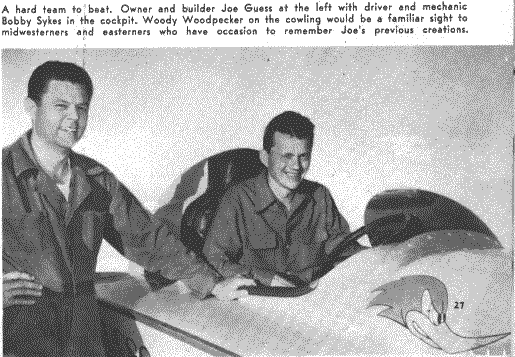
The superstructure of the "Guess Who" resembles a racecar. From a beautiful louvered hood to the end of the tail (all metal work by Joe), everything is in order. Driver comfort is well considered. The cockpit features a spring steel steering wheel, padded head rest, a seat cushion that will put you to sleep in no time at all, And a windscreen that is very essential when you are traveling over 100 M.P.H. A full compliment of instruments is carried. Nothing that can be used to an advantage is left out. By the same token nothing goes for a free ride if it is useless.
While far from being a light boat, the "Guess Who's" weight is kept to a minimum by the use of aluminum where possible. Aircraft construction is carried out by the use of steel tubing for motor mounts. These mounts are carried on dural channels that are fastened to longitudinal stiffeners. These channels are at propeller shaft angle and are drilled every few inches to permit the engine to be shifted fore and aft to trim the boat for proper riding balance. 'The propeller shaft thrust bearing is mounted to the engine. A long coupling permits a change in engine location without disturbing the position of the propeller shaft.
A long rudder blade of heat-treated alloy steel is ground to a knife-edge. Easy access to the inside of the transom, by removing the tail, permits the rudder assembly to be moved out of the slipstream or the propeller if desired. Steering cables are connected to a roller chain and sprocket at the steering wheel end and to a full circle spool at the rudder. There is no possibility of the cables becoming slack, regardless of rudder position.
The tail strut, which has caused some debate among the experts, is designed in the form of a Vee. Fabricated from steel plate, it provides a very rigid support for the propeller shaft. Water from the cooling system lubricates and cools the rear strut bearing as well as the intermediate bearing, a practice long advocated by Hi Johnson. Hi says much propeller hub cracking can be traced to overheated strut bearings. The bronze propeller when heated, expands faster than the shaft, this causes the propeller to slip forward on the taper. Continued heating and cooling, expands the hub to the point of breaking. Apparently Joe is not being to have this trouble. The hull is of plywood construction throughout. 16'-3" overall with a ten foot afterplane, the hull appears quite large. The 7'-5" beam is carried well forward giving the nose a rather square inverted scoop shovel effect. This gives the hull considerable air lift which is needed to carry the heavy power plant. The tunnel measures 48" between the runners. The bottom is made up of 1/4" five ply aircraft poplar. The last two stations are beefed up with 3/4" five ply making the total thickness 1" in this area. This is where the rear strut is located so it was built to take a beating. The transom is a sandwich affair consisting of 3/4" spruce backed up with 1/4" three ply poplar. The sponsons, or runners, as you prefer, are built up of 1/4" three ply fir covered with 1/4" five ply poplar. Ski wedges 5 1/4" wide, tapering from 1/4" to 7/8" provide the actual planeing surfaces at the higher speeds. Sponsons deck anti hatches are covered with 44" three ply birch. Every piece of wood in the hull is glued: even the deck is glued to the frames. Needless to say, the boat is flawless.
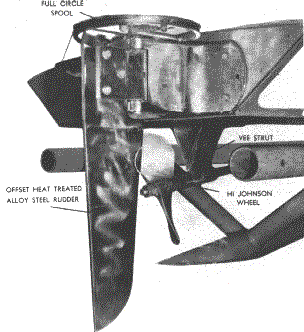
The power plant, a bored out Mercury, was built in the shops of Clay Smith and Danny Jones. Bobby Sykes, who holds down the job as driver of the "Guess Who", is employed by these two gentlemen, whose "know how" of racing machinery has built for them an enviable reputation. Bobby built up the new powerhouse, and Clay Smith has waved his magic wand over the engine (we are told) so its success is doubly assured. 3-5/16" bore with a 3-3/4" stroke, the engine figures 258 Cu Ins., well under the limit of 266. There is little the engine doesn't carry in the way of last word equipment, fuel injection, magneto, dry sump lubrication and forged pistons. This writer, who was measurer at the Salton Sea Regatta, had a chance to peek inside the engine of the new world record holder. The even distribution of fuel, (methanol) as shown by the carbon deposits, is something to see. It was impossible to distinguish one cylinder from another. Spark plug colorings were identical. Anyone who has run a marine engine knows how difficult it is to get good distribution with the engine sitting on an angle. With fuel injection the engine could run upside down with little effect on distribution.
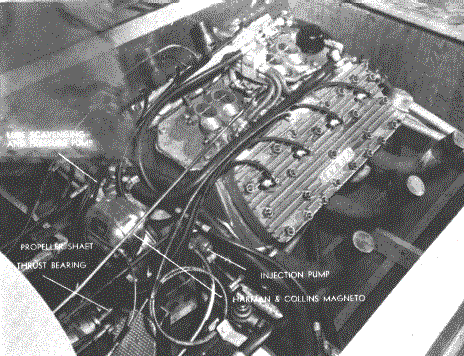
The performance of the engine is remarkable, when you consider that it turns a large prop 6,900 revs. This is equal to a piston speed of 4,300 ft. per minute. Few flat head engines can run at this piston speed and still stay together. Prop shaft is 1" "K" Monel. Propeller is of course a Hi Johnson product. While only Hi knows what the pitch is, rumor has it that the wheel used in the run at Salton was a 12 x 23. Well, that just about does it. You would have to see the "Guess Who" to fully appreciate it. Better yet is to see it in action. To borrow an expression from my teen-age son, "It's real George, yessir, real George!" (I say, "It's real Joe!").
